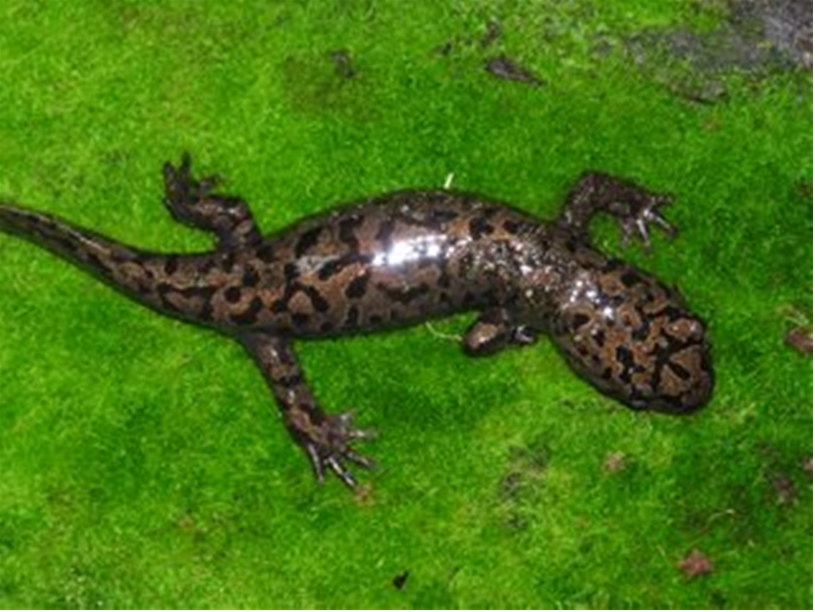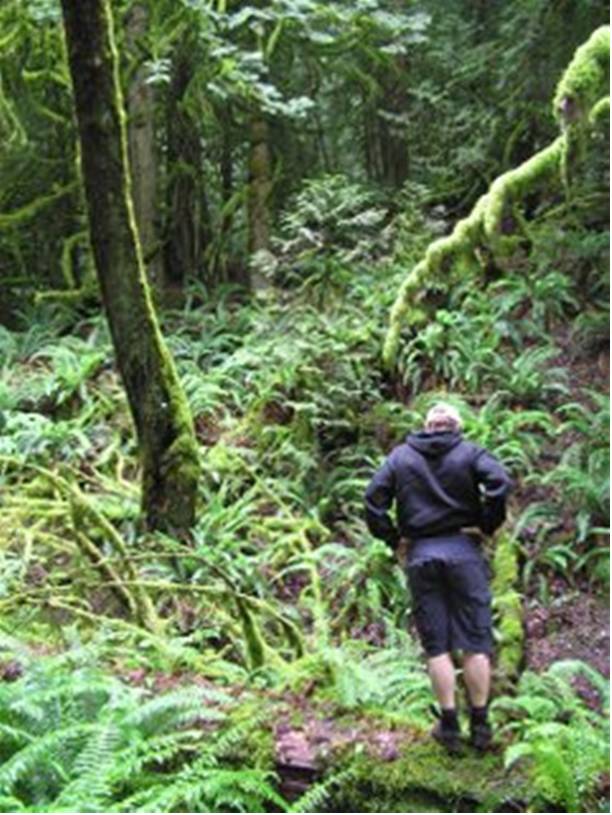

NATURE NOTES

Coastal Giant
Salamander, photo by Hugh
Griffith
The Search for the Giant Salamander
by
Perhaps I became a zoologist the summer my parents rented a cottage in the rugged Canadian Shield country north of Toronto. That is where I rolled a piece of cordwood to discover my first Red-backed Salamander, a shiny noodle-thin animal with tiny limbs and a charming, bright-eyed face. I was hooked.
Years later, as a graduate student, I was again in the shield country in the warming days of early April, assisting my friend and lab-mate, Les, with his studies of the somewhat heftier Blue-spotted Salamanders that bred beneath the ice of beaver ponds. It was great fun, waking early and toiling late into the night, trying to decipher the workings of the lives of creatures unknown to most of the world.
Les and I lost touch until this past spring when we met on the UBC campus. It was soon clear that we could not escape our old selves - in no time at all we agreed to a quest, to find a Coastal Giant Salamander, a species that in our younger days was exotic, mysterious, and far away. The Coastal Giant is aptly named, a thick-bodied, bulgy-eyed behemoth that dwarfs the species we had known in Ontario. In its own way it is beautiful, as are all salamanders.
Within a week we were heading up the Fraser valley, with only vague information from field guides to help direct our search. Range maps for the species show indiscriminate blobs covering the Chilliwack valley, and range descriptions say, "in and around the streams that run into Cultus Lake and Chilliwack Lake." Not a lot to go on.
Even knowing that giant salamanders are found at a particular locality only slightly improves the chance you might see one, because they will either be within fast-moving, boulder-strewn streams, or in tunnels or other spaces within the soil. They are one of many little-known, almost invisible animal species in southern BC that are in danger of disappearing as mountainsides are cleared and development spreads through the lowlands. They are provincially Red-listed, which means they are considered threatened in the province.
We picked our way up the banks and through the numbing water of streams along the south shore of Cultus Lake, carefully checking beneath what biologists call, "coarse woody debris," what normal people call, "logs," striving to leave things as they were, keeping in mind that any contact with wild things can cause harm. One aspect of salamander searching had changed since we were children, or 20-somethings. Back then, we only grunted when straining to turn the log or stone, not when merely crouching down to grasp it.
Several logs harboured Western Red-backed Salamanders, slender, lungless cousins of the salamanders from the cottage woodpile in Ontario. This species lives in the damp niches of the forest, breathing through its skin. Eggs are deposited on land, and guarded by the females until hatching. We found that Western Red-backed Salamanders can also have yellow backs, or can be entirely black. It is possible to find several beneath a single sheet of bark, all of different colours. Very nice, but not the Coastal Giant.
That day we travelled from Cultus Lake to Chilliwack Lake and back, without success. We would have to try again. It had become an important thing, this quest, which started, now that I think about it, when we were children.

Les on the hunt, photo by Hugh
Griffith
Two weeks after the previous attempt, my former colleague, Les, and I were again driving east, toward Chilliwack, determined to find our large amphibian Grail, the Coastal Giant Salamander. We planned to circumnavigate Cultus lake as much as roads allowed, and stop at every roadside stream that seemed "right."
We had a slightly better idea where to look, and a slightly better idea of what "right" was. Giant salamanders live in and around mountain streams, their lives connected to the cool, oxygen-rich water and adjacent humid slopes. The fast-moving water should be interrupted by placid pools in which eggs are laid and larvae hatch and grow. The stream has to be shaded, in old growth or well established second-growth forest. A peculiarity of the species is that some individuals never fully transform to adulthood. These neotenes grow large, but retain their external feathery gills and never leave the water. Therefore streams have to be large enough not to dry up in late summer, on mountainsides that have been undisturbed for many years.
There would have been many more such streams a century ago, even a few decades ago, before clear-cutting scalped the upper slopes of the region, burdening the watercourses with silt and slash, and unwittingly snuffing out one amphibian population after another. A century ago, a hunt for a giant salamander would have been little challenge at all. It would also have been rather low on the average pioneer's "to do" list.
Stream after stream we climbed, with no sign of the creature. What was wrong? Was the flow too weak, a seasonal trickle that would run dry in August? Or was it too powerful, would wash larvae away? Several promising hillsides were inaccessible, being either on private property or Department of National Defence land, whose signs warn you off in both official languages. By late afternoon we were heading south, and the GPS unit teetering on the dashboard indicated we were approaching a thick black line - the US border. We could see its scar cut through the forest up ahead, where on the other side there were likely many giant salamanders waiting to be discovered, but also over-eager Minutemen, video cameras and heat sensors. In this world of shoot-first, ask questions later, we decided not to risk it, especially when the answer is, "Uhh, looking for giant salamanders."
It seemed the end of the road, and of our quest, when suddenly there it was, sparkling through the trees, white water tumbling over rocks, running down to the ditch, the perfect stream. We searched and searched, bent over, backs aching. I found myself asking, Why were we doing this? Les, too, was having doubts, suggesting reasons why, perhaps, this was not the perfect stream after all - canopy too open? Wrong under story? "They're here!" I asserted, without any justification. I was standing a few feet from the stream, next to an ancient maple, its thick base collared by sheets of loose bark. "They have to be here," I repeated, determinedly. I turned to head uphill. As I moved away, Les stepped forward and folded the bark from the tree.
"Hugh," he said. And then, as if announcing the winner of a contest, "The Coastal Giant Salamander."
There it was, nestled in the loamy dirt, a blunt-headed, bug-eyed creature, mottled black and copper, the real thing. It was exactly where it should have been, doing exactly what it should have been doing, but still we were surprised -- for how often do you find a Grail, no matter how hard you search?
After taking a few pictures and returning the creature to its home, I turned the GPS back on -- to mark our location. One by one the satellites appeared on the little screen until finally a reading was granted. It was a sign from above, our quest was done.
Hugh Griffith is a BC zoologist and science writer.
Please cite these pages as:
Author, date, page title. In: Klinkenberg, Brian. (Editor) 2023. E-Fauna BC: Electronic Atlas of the Fauna of British Columbia [www.efauna.bc.ca]. Department of Geography, University of British Columbia, Vancouver. [Date Accessed]
© Copyright 2023 E-Fauna BC.